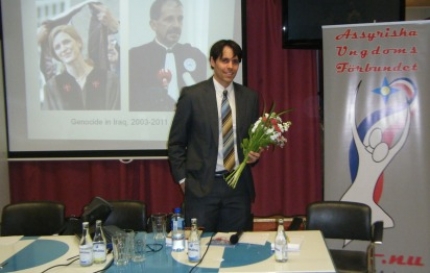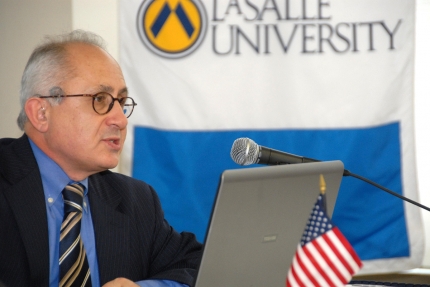Can you tell us about your personal and academic background?
I was born in England during World War II and grew up in the United States. My father’s family is all English from Yorkshire, my mother’s family is Jewish from Ukraine. I came to Sweden in 1968 and have lived here ever since.
I have taught at Uppsala, Umeå and Södertörn universities. In addition I have led research at the Swedish Institute for Future Research and for Stockholm Social Services. I have written, co-written or edited about twenty books and over one hundred articles. Most of my early research was on Swedish social history or contemporary social problems. Besides writing about the Assyrian genocide I have written about genocide and mass violence against Jews, Roma (Gypsies), Kurds and Armenians.
When did you initially learn of the Assyrian Genocide and what sparked your interest in writing about it?
I was giving a lecture on the Jewish and Roma Holocaust sometime in the late 1990s. Some of the listeners came up afterwards and said they were Assyrians and asked me if I knew anything about the Assyrian genocide. I said I knew nothing, but was willing to learn if they had any literature, documents and so on. After a time one of them came back with the only thing he could find at that time, which was Suleyman Hinno’s collection of oral history of Seyfo in Tur Abdin. This began my collection of literature and documents. The students also introduced me to Jan Betsawoce who had a private collection of works on Assyrian issues and we began to co-operate and he became my assistant. Together we have tried to build up a complete collection of books, articles and archival documents on Seyfo. We have collected from Turkey, Lebanon, Syria, Armenia, Georgia, Russia, the Vatican, USA, England, France and Germany. Both of us are very interested in languages. From the beginning, the primary need was to make available the books and documents that had been forgotten or were written in unusual languages. We have translated quite a number of older sources into Swedish or English and will keep on doing this. Usually we get sponsorship for printing the books from local Assyrian groups or associations, and for this we are very grateful. However, after a while it became obvious that just publishing documents was not enough and we began to analyze the findings and put them into modern genocide research and began to publish articles and books based on original research.
Are you currently undertaking Assyrian Genocide related research? If so, what areas and sources are you presently examining?
At present I am working on making a sociological profile of the perpetrators of the genocide in order to see what their motives were. I am also examining the long-term relations between Assyrians and Kurds as many sources mention that Assyrians were sometimes aided and supported by individual Kurds and Yezidis and even whole tribes. What was the background to this co-operation? Jan Betsawoce and I are in the process of publishing translations of the rather obscure French-language journal L’Action Assyro-Chaldéene, which was published in Beirut in the early 1920s and was a major Assyrian information channel for the politically engaged. It took us a very long time even to find issues of this paper. Also we are preparing a bibliography of books and articles dealing with Seyfo, we are not yet finished, but it is more than 70 pages long. We think this will be a very important reference work.
Your book ‘Massacres, Resistance, Protectors: Muslim-Christian Relations in Eastern Anatolia During World War I’ can be considered amongst the most important, if not the most important contemporary primary-source work on the Assyrian Genocide. What advice would you give to both Assyrian and non-Assyrian scholars interested in Assyrian Genocide primary-source research?
My advice has several points. We must have more archive research as there are many blank spaces. For instance, the archives in Iran have not been used yet, but what has been published gives great insight into what was happening in the Turkish-Iranian border strip where the first Assyrian groups were massacred already in February 1915 and where a second wave of massacres occurred in 1918. Can we see who ordered the assassination of Mar Shimun? Also the Turkish military-history archive obviously has a vast material on the actions of troops against Assyrian villages. We have just scraped the surface with our work on the siege of Azakh and there were about 30 different documents on this in that archive. There should be equally as much documentation for the battle for Midyat and the siege of Aynwardo. There should be very much about the military campaign against the Nestorian tribes in Hakkari. We have the feeling that there are lots of generations’ old private papers that could give new perspectives on events: there are manuscripts in people’s attics and storage rooms that can give great detail about events. As we were working on the siege of Azakh, many different families came forward with diaries, poems, chronicles and so on that dealt with the Turkish siege of that little town. Similar materials need to be recovered, restored and in case they are very important, published in edited form. Many central places of documentation are not yet open for research. For some strange reason the family of General Agha Petros deny access to his papers. And my assistants have not succeeded in accessing the archive and libraries of the Syrian Orthodox Patriarchate in Damascus or the Syrian Catholic monastery in Sharfe, Lebanon where one of the most important early writers on Seyfo, Ishak Armale was a teacher. We would very much like to read his manuscripts. Further, researchers need to put the genocide into comparison with all of the other major genocides. What happened to the Assyrians was different from what happened to the Armenians – why? For instance the Armenians were deported on long death marches, but the Assyrians with few exceptions were killed in their home villages without deportation. There was much political hate-speech against the Armenians, but very little of this towards the Assyrians, even so both groups were eradicated. We need more work with a gender perspective on the fates of women and children. More attention should be placed on the righteous Muslim neighbors who protected their Assyrian neighbors.
Although the Assyrian Genocide recognition movement has expanded and gained greater attention during the last decade, do you consider the frequency of scholarly publication on the issue to have slowed during the same period?
No I don’t think scholarly publication has slowed down at all. Before 2000 almost nothing had been written on Seyfo that one could even consider calling scholarly. The only exception that comes to mind is Joseph Yacoub’s dissertation at the Catholic University in Lyon, France. It deals mostly with how the League of Nations dealt with the Assyrian question, but it touches on the genocide in its background chapters and it is still a very useful piece of research. The influential works written in the 1980s by the American professor John Joseph gloss over Seyfo, and can therefore be used by those who stop genocide recognition. Almost everything we now know about the details has come in the last 10 years.
How important is the staging of frequent scholarly conferences on the Assyrian Genocide? Do you feel that the frequency of such conferences is insufficient or that too often it is Assyrian activists organising these conferences rather than universities or scholars themselves?
Actually there haven’t been very many academic conferences on the Assyrian genocide at all. But it does happen that when scholars working with the Armenian genocide gather they invite someone to present the Assyrian case. It would be very good to have meetings that were exclusively dedicated to the Assyrian genocide issue. A first meeting of this type will be held in Holland in June this year. It may prove an embryo to something greater.
In 2007, the International Association of Genocide Scholars recognised the Assyrian Genocide. Since then, do you think that IAGS has done enough to support Assyrian Genocide scholarship or advocate for Assyrian Genocide recognition?
Yes, the IAGS has recognized the Assyrian genocide along with that of the Greeks. I am not a member so I don’t know the background very well and I don’t know what kind of evidence they were presented with. This is a mixed association of scholars and activists, but has as far as I know it has no international political influence and does not have a lot of money. The organization had a conference in Sarajevo in 2007 and there took a vote on a petition presented by some of the membership. I don’t see what they could do much more that make their declaration and spread it. I have heard that the organization’s president Israel Charny has recently put on the internet some articles on the Assyrian and Greek genocides, but I have not read them. I think if we are looking for more influence and funding it must in the first hand come from inside the Assyrian community itself. As it is now only a few –as we say in Swedish “souls on fire” in Sweden, Holland and the USA have privately supported research and that has been mostly in the form of paying for translations, printing costs or enabling research trips. This money is a very welcome form of help, but there is a need for more continuous support. Support for research on Seyfo should be coming from a much larger part of the Assyrian community, otherwise it will look as if the Assyrians themselves don’t think this event was particularly important.
As you are aware, scholars focusing on the Assyrian Genocide are few. Why do genocide scholars broadly speak so little about the fate of co-victims of the Ottoman Empire’s genocide (the Assyrians and Greeks), as opposed to that of the Armenians?
Genocide scholars are more and more aware of the Assyrian genocide. What scholars need is the results of new research. More and more the Assyrian case is mentioned in general genocide text-books and new editions of older works have new sections covering Assyrians. But we are starting from a very, very low level of knowledge and with very little resources other than the few burning-soul activists, who are not always given the credit that they deserve. The Armenians have a much longer tradition of research and they have produced many more books and articles. The Assyrian community cannot expect the same amount of attention, until it too has produced its own research and has presented its evidence. Most important: the Armenian community has co-operated with universities for a very long time. There are professorships sponsored by Armenians in many universities in USA and there are many universities that have programs in Armenian studies like UCLA, Michigan, Dearborn, Fresno etc. The Armenians have built up a major international research library in Paris based on the collection originally assembled by Nubar Pasha and there is a very good research center and library in Watertown, Massachusetts. The Assyrian community needs to build up similar intellectual resources.
By Naramsin Daro



